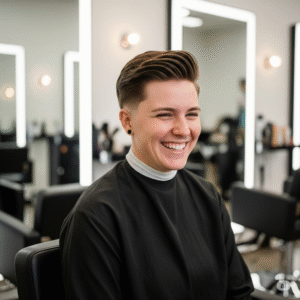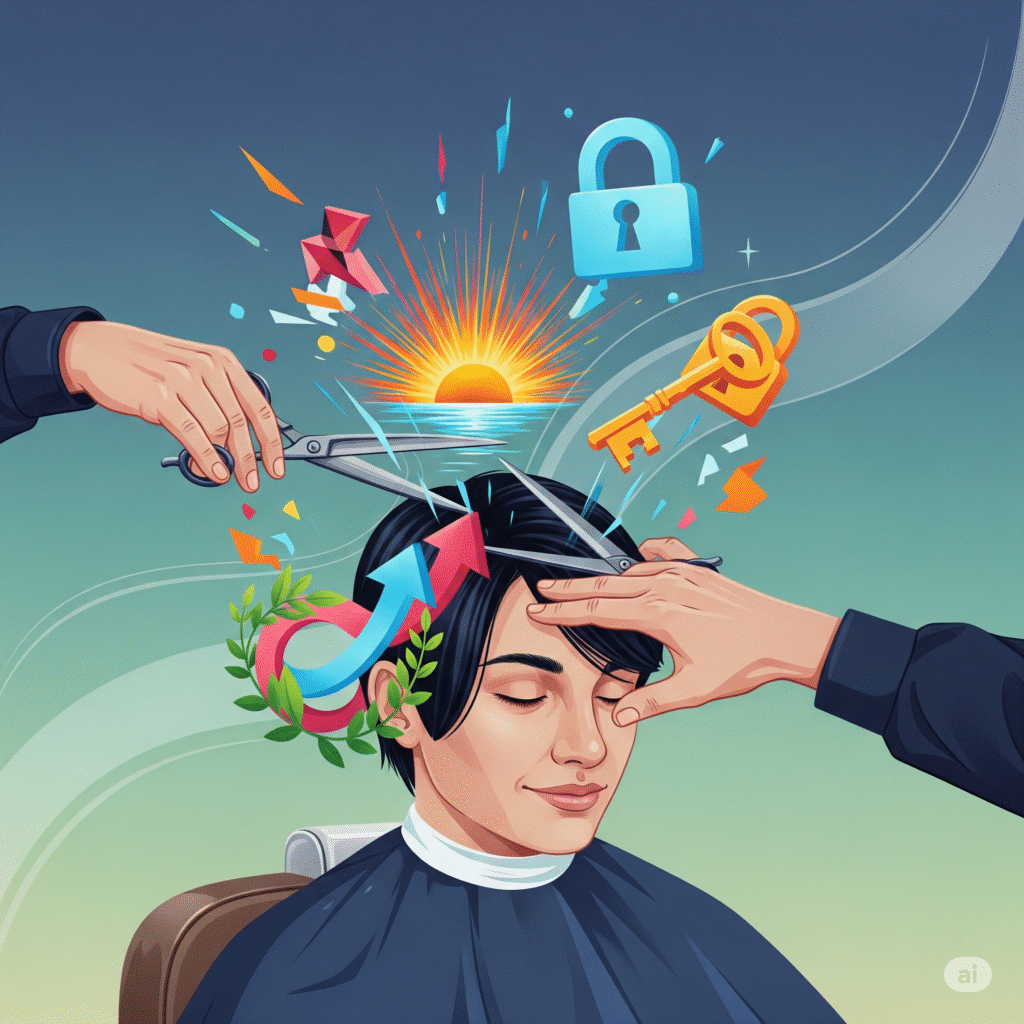A New Haircut for a New Start? The Astonishing Connection Between Haircuts and Your Well-Being 💇♀️
We all have been through this at one point in our lives: after a nasty breakup, a hectic period at the workplace, a setback in the public eye, or feeling stuck in your life, the first thing that comes to mind is to change the scene of our life and make things better, or do something that drastically changes the scenario. For many people, that change lies in the salon chair. This situation is commonly used in TV shows or movies- a drastic transformation of hair occurs after a major and dramatic life event. Is it just a new haircut, or is it a new start to your life?
Is there more to this phenomenon?
Is it only a sudden desire for a fresh and new look? Or an excuse to get the feeling of a fresh start? Is there a genuine connection between your haircut and your well-being?
We all know that a new hairstyle or cut doesn’t have magic to solve our problems. Still, the feeling of a new and “fresh start” that is attached to a new haircut is a strong psychological tool that can drastically impact your mood and help you manage your stress, anxiety, and even depression.

The Deep-Rooted Psychology of the Haircut 🧠
The association between our hair and our personalities is far deeper than the “look beautiful” phenomenon.
From the start of human history, hair has had a symbolic meaning across many cultures. Cooper (2009) notes that it can symbolize passion, class, power, femininity, masculinity, revolution, unity, mourning, and revitalization.
An example can be Samson, whose strength was tied to his long locks, or the shaving of heads in many cultures, which is connected to spiritual rituals. In short, our hair plays a crucial role in our identity, and changing our hairstyle or getting a new haircut can reveal who we are or who we aspire to be.
The action of getting a new haircut, particularly a drastic one, is a profoundly symbolic act of starting something new.
Leary & Tangney (2012) assert this relationship, expressing that physical appearance is closely linked to our self-identity.
According to researchers Dai, Milkman, and Riis, “the concept of a ‘fresh start’ directly relates to a feeling of renewed energy and motivation to take action. It provides a scientific explanation for why we feel more empowered to make changes at certain times.”
It serves as an indication and gives a strong physical and psychological signal that a new chapter of a new life is about to begin, and the old one is left behind. When we opt for a new, fresh look through getting a new haircut, we are taking a powerful decision to change our appearance, Adam & Galinsky (2012) refer to this as “enclothed cognition,” indicating that the metaphorical meaning of our appearance can impact our psychological state and this shows strong sense of self-control, even when the life is tough, overwhelming and chaotic.
This sense of agency is incredibly essential for those struggling with stress and anxiety, where everything feels out of control.
This simple decision to trim off inches, change our hair shade, or adopt a daring new style can be an empowering confirmation: “I am choosing this, because I am capable of changing and controlling my life situation.”
Likewise, a new hairstyle can significantly change how we look in the mirror, but it often helps us boost our self-esteem and make us confident. Vrij & Semin (1996) have illustrated how hairstyles impact not only how we perceive ourselves but also how others perceive us.
A desire to “look good” in the mirror can sometimes reflect in other areas of your life, and it can play a huge part in impacting your mood, energy, and even your point of view of the overall perception of life.
It’s the profound, yet often undervalued, impact of a fresh look on your mind– a visual reminder of your capability for change and resilience.
A Cut Above: Connecting to Depression and Anxiety

For people who are struggling with depression and anxiety, a new hairstyle can be much more than a new look; it can be a strong reminder of self-care.
Neff (2011) emphasizes self-compassion as a key component of well-being.
Depression often drains one’s energy and motivation to participate in the basic act of self-maintenance. The simple act of booking a salon appointment, having your hair washed in a salon, or making a decision about your hair change can be a strong indication of intervening and breaking a cycle of neglecting yourself for a long period that has made your state depressive. It is a very little, yet profound commitment to yourself, where you declare: I am worth the effort, I deserve another chance.”
The quick gratification of witnessing a new reflection can deliver a little but essential dopamine boost, offering a ray of hope and a definite reminder that cheerful changes are achievable. Similarly, for those going through a period of anxiety, a small modification or change like this can play an instrumental role in challenging negative thought patterns.
When your mind is in a constant state of fear and continuously racing with worries, shifting focus to and experiencing a new, softer style or the compelling vibrancy of a new hair color can provide a brief but much-needed mind reprieve. The visible result of a haircut you like can likely help you think positively about your situation, and help you create a momentum that can boost your mind to take constructive action rather than paralyzing rumination.
These little steps can lead towards actions that can reinforce the idea that you have the power to change and influence your reality.
A new haircut can also provide a sense of closure. It might be a possibility that a particular hairstyle reminds you of a period that was traumatic for you, such as a relationship or a struggling time period; changing it can indicate the physical disconnection from your past. It is like an opportunity that literally helps you free yourself from what no longer comforts you, providing a space for new adventures and a new sense of yourself.
Real-Life Transformations: Celebrities and Their Cuts
The phenomenon of getting a new hairstyle or changing one’s physical appearance is most common in the lives of superstars, and their every transformation is of public interest and broadly discussed among the audience.
Solomon (2020) examines how transformations in appearance are usually used as a form of nonverbal communication to signal individual and social transformations. Many well-known superstars are using their dramatic change in their hairstyle to highlight a major shift in their lives or just to get attention during their intense period or struggle. It gives the public an idea that something has changed in that person’s life.
To name one example, we can see the famous example of Britney Spears, who, in 2007, amidst a highly publicized personal crisis and harsh media scrutiny, surprisingly showed up with a shaved head.
This drastic action highlighted the profound relationship between personal freedom and outward appearance.
There is another prominent figure who is worth discussing here, who uses hair as a symbol of evolution, and that figure is Miley Cyrus. After her long stint as Disney’s wholesome star, Cyrus famously chopped off her lengthy hair into a bold, edgy pixie cut in 2012.
This change was in direct contradiction to her, as she tried to change the childhood image, and she succeeded by creating a more rebellious musical persona. The new haircut wasn’t just aesthetic; it was a transparent public proclamation of her transition, and a visible break from her past, empowering her to adopt a more genuine, self-dependent identity after years of being described by a corporate brand.
These examples highlight the profound relationship between our physical representation and our emotional terrain.
For public figures and individuals, a new hairstyle is not about changing how you look; it is often about how you feel, and how you steer the world, presenting a strong, visual manifestation of internal turmoil or victory.
Ultimately, the power of a new haircut isn’t in what it removes from your hair, but in what it could help you with or help you to repair within yourself: a feeling of hope, a sense of resumed control, a conncetion between your new haircut and your wellbeing, and a decisive confidence that a new beginning is not only possible but already on its way.
So, next time when you feel the desire for a drastic hair change, listen to that impulse – it might just be your psyche yelling for a new or fresh start.
Disclaimer: This article is intended for general learning and informative purposes only. It is not a replacement for professional medical advice, diagnosis, or treatment. Always seek the advice of your doctor or other qualified health consultants with any questions you may have about a medical disorder or mental health problems. Never disregard professional medical advice or delay in seeking it because of something you have read in this article.
References
-
Adam, H., & Galinsky, A. D. (2012). Enclothed cognition. Journal of Experimental Social Psychology, 48(4), 918–925.
https://doi.org/10.1016/j.jesp.2012.02.008 SCIRP
Cooper, W. (2009). The Cultural Symbolism of Hair. Folklore, 120(2), 195–212.
(DOI not readily available in the sources searched)
I wasn’t able to locate a DOI or direct online link for this specific article within the volumes accessible. If you have access to your institution’s library or Folklore’s archive (via Taylor & Francis), that may help you retrieve it.
Dai, H., Milkman, K. L., & Riis, J. (2014). The fresh start effect: Temporal landmarks motivate aspiring and resolving selves. Management Science, 60(10), 2563–2582.
https://doi.org/10.1287/mnsc.2014.1901 INFORMS PubsOnlineSSRNJSTOR
Leary, M. R., & Tangney, J. P. (Eds.). (2012). Handbook of Self and Identity (2nd ed.). Guilford Press.
ISBN-13 (paperback): 978-1462515370 Guilford PressRoutledge
Neff, K. (2011). Self-Compassion: The Proven Power of Being Kind to Yourself. William Morrow.
ISBN-13: 978-1444738179 AmazonAbeBooksColorado Mountain College
Solomon, M. R. (2020). Consumer Behavior: Buying, Having, and Being (13th ed.). Pearson.
ISBN-13: 978-1292318103 AmazonPearsonPagePlaceGoogle Books
Vrij, A., & Semin, G. R. (1996). The relation between hairstyle and person perception. The Journal of Social Psychology, 136(6), 683–690.
DOI not located in sources. Related work includes Vrij, Semin, & Bull (1996): “Insight into behavior displayed during deception,” Human Communication Research, 22, pp. 544–562—but this appears to differ in volume and page numbers ResearchGatesmg.media.mit.edu.



